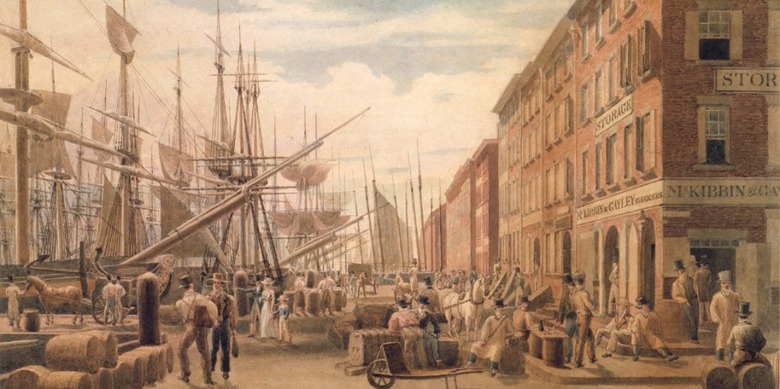- Subject:
- U.S. History
- Material Type:
- Module
- Provider:
- Ohio Open Ed Collaborative
- Tags:
- License:
- Creative Commons Attribution Non-Commercial
- Language:
- English
- Media Formats:
- Text/HTML
Education Standards
Industrial Revolution - Exercise Two: the System
America and the Industrial Revolution 1800-1850

Overview
In the early years of the nineteenth century, Americans’ endless commercial ambition—what one Baltimore paper in 1815 called an “almost universal ambition to get forward”—remade the nation. Between the Revolution and the Civil War, an old subsistence world died and a new more-commercial nation was born.
[Image: William James Bennett, View of South Street, from Maiden Lane, New York City, c. 1827, via Metropolitan Museum of New York]
Learning Objectives
- Explain ket developments in the national economy, including the rise of business, growth of cities, and changes in federal land policy.
- Analyze the factors that led to the Panic of 1819, assessing the Panic's impact upon the nation.
- Identify and describe key developments in transport technology, explaining how they contributed to the formation of a national economy.
- Describe the process of industrialization in the Northeast, comparing and contrasting the Northeast with other regions in the United States.
- Identify the sources of labor used by the early textile factories and the Northeast.
- Describe the development of communications technology, especially the telegraph, and explain how they improved communications on a national level.
- Identify the formation of social classes, explaining how they developed as a consewuence of industrialization.
- Describe the people who comprised each level of social class.
Textbook Readings
LUMEN BOUNDLESS -- U.S. HISTORY - "The Market Revolution 1815-1840"
- The Market Revolution
- A Market Society
- The Industrial Revolution
- Limited Prosperity
- Conclusion: An Industrializing Economy
OPEN STAX -- U.S. HISTORY
AMERICAN YAWP
Module Supplemental Readings/Videos
- American Economic Growth, 1800-1860 (Sage Amefican History) http://sageamericanhistory.net/expansion_manifestdestiny/economicgrowth1800_1860/index.html
- The Erie Canal www.eriecanal.org
- The First American Factories http://www.ushistory.org/us/25d.asp
- The Growth of Slavery and Southern Railroad Development (Railroads and the Making of America) http://railroads.unl.edu/views/item/slavery_rr
- The History of the Electric Telegraph and Telegraphy https://www.thoughtco.com/the-history-of-the-electric-telegraph-and-telegraphy-1992542
- Northern Expansion in the 1850s (Railroads and the Making of America) http://railroads.unl.edu/views/item/landsales_IL
- Passenger Mobility in the 1850s (Railroads and the Making of America) http://railroads.unl.edu/views/item/pass_mob
- Philadelphia and Lancaster Turnpike www.explorepahistory.com
- Southern Railroads and Freight Traffic: Cotton Only or More? (Railroads and the Making of America) http://railroads.unl.edu/views/item/Charts
- Steamboats https://about.usps.com/who-we-are/postal-history/steamboats.pdf
- Technology, Modernity and the U.S. South Before the Civil War (Railroads and the Making of America) http://railroads.unl.edu/views/item/ga_cotton_1860
MULTIMEDIA SOURCES
- Classroom: The Cotton Gin https://www.pbs.org/video/african-americans-many-rivers-cross-cotton-gin
- Cotton Gin Cart Demonstration https://www.youtube.com/watch?v=JzHD7_dWEik
- Cotton Gin-Machine in Action https://www.youtube.com/watch?v=gxA65N4ruc
- The First 13 Miles (B&O Railroad TV Network) https://youtube.com/watch?v=2vXMSQyeVlg
- How the Cotton Gin Changed America https://www.youtube.com/watch?v+bns6aKfrljA
- The Massachusetts Mill Workers, Lowell National Historical Park https://www.youtube.com/watch?v=zSV6axNHkQ
- Road Building in Early America (Discerning History) https://www.youtube.com/watch?v=jaN382Pphkg
- The Telegraph: A History https://www.youtube.com/watch?v=pkafFxtc8A8
- Transportation: Trails & Roads, Canals and Railroads (National PArk Service -- Ohio and Erie Canal National Corridor) https://www.nps.gov/nr/travel/ohioeriecanal/transportation.htm
- U.S. History: Pre-Columbian to the New Millenium -- Chapter 22a: Economic Growrth and the Industrial Revolution http://www.ushistory.org/us/22a.asp
PRIMARY SOURCES
- Railroad Maps, 1828-1900 (Library of Congress Digital Collections) https://www.loc.gov/collections/railroad-maps-1828-to-1900/about-this-collection/
Glossary of Key Terms
American System: Henry Clay's three-pronged system to promote American industry. Clay advocated a strong banking system, a protective tariff and a federally funded transportation network.
artisan: Skilled workers drawn from all levels of society from shoemakers and tailors to silversmiths and furniture makers.
cotton gin: A machine that sped up the process of harvesting cotton, thus making cotton cultivation more profitable, and increasing the importance of slavery in the South.
Cumberland Road: National Road, stretched along 600 miles and was the first federal highway in the United States of America and originally served as the main route to the Northwest Territory.
Erie Canal: New York state canal that linked Lake Erie to the Hudson River. It lowered shipping costs, and increased the profitability of farming in the Old Northwest.
Era of Good Feelings: Name for the period of one-party, Democratic-Republican, rule during James Monroe's presidency.
Liberia: West-African nation founded in 1822 as a haven for freed blacks, fifteen thousand of whom made their way back across the Atlantic by the 1860s.
McCormick reaper: Mechanized the harvest of grains, such as wheat, allowing farmers to cultivate larger plots.
market revolution: Eighteenth- and nineteenth-century transformation from a subsistence economy to a national commercial and industrial network.
Panic of 1819: Severe financial crisis brought on primarily by the efforts of the Bank of the United States to curb over-speculation on western lands, disproportionately affecting the poorer classes, sowing the seeds of Jacksonian Democracy.
specie: "hard money," typically coinage of gold or silver.
transportation revolution: Innovations -- turnpikes, steamboats, canals, and railroads -- that linked local and regional markets, creating a national economy.
Instructor Resources
See Attached Exercises